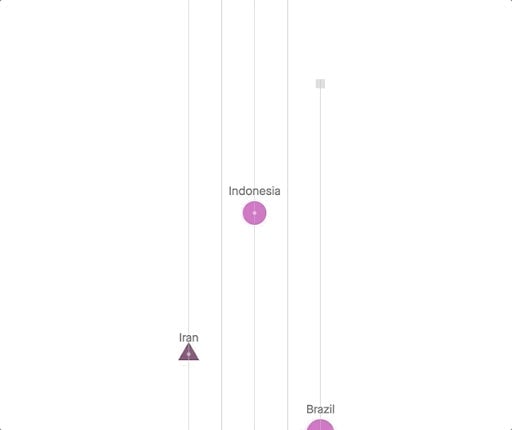Climate goals on life support
Hi Quartz readers,


Hi Quartz readers,
COP26 had one job: To keep 1.5 degrees Celsius, the global warming target prescribed by the 2015 Paris Agreement, alive. After two weeks of frantic negotiations and a bewildering blizzard of carbon-cutting commitments, 1.5 still has a pulse. But it’s on life support.
“1.5 is still alive if we don’t rest on our laurels and see how things go,” Nigel Topping, a veteran climate economist tasked with drumming up private sector action during the COP, said in an interview on the summit’s last day.
By the time the gavel fell at 8:07pm GMT on Nov. 13, COP26 had yielded a number of noteworthy achievements, including the first-ever (albeit watered-down) mention of fossil fuels in a UN climate agreement, India’s first commitment to reach net-zero emissions (by 2070), and an agreement by all governments to accelerate their deadline to publish more ambitious climate goals.
Overall, if countries follow through on their commitments (a gigantic “if”), temperature rise by 2100 could be limited to 1.9°C, according to Carbon Brief. Based on existing policies, a more likely outlook is around 2.4°C. The best proof climate diplomacy is working is that before Paris, the projection was as high as 3.7°C, a truly nightmarish future that’s now very unlikely. But now the lowest-hanging fruits for carbon abatement are plucked—bending the curve all the way to 1.5 will be much harder.
For that to happen, countries will need to ratchet up their commitments every year. Governments, the media, and civil society groups especially need to hold the private sector accountable for its net zero commitments, and demand a climate action plan from every company. And rich countries need to finally follow through on their long-neglected promise to provide funding for clean energy and climate impact adaptation in poor countries—a promise so neglected in Glasgow that the failure was condemned in the formal agreement.
Scientific uncertainty about the atmosphere’s exact sensitivity to greenhouse gases leaves open the possibility that 1.5 may already be in a coma. But mounting public pressure—fueled by the deepening climate crisis itself—could wake it up.
“1.5 stretches credibility,” said William Pizer, a former US climate negotiator and current vice president for policy engagement at Resources for the Future, a think tank. “But 2C is really possible, and just a few years ago it really wasn’t.”
No country is doing enough
Prior to COP26, there was one country in the world pulling its weight on climate change—The Gambia. It was the only nation, according to the analysts at Climate Action Tracker (CAT), that had targets and plans compatible with 1.5ºC warming. Last week, however, the country’s updated climate plan was assessed and its rating was downgraded from “Paris Agreement compatible” to “almost sufficient.” Now, none of the nearly 40 countries in the CAT’s analysis are on track.
See the most recent data on how well countries are doing with their pledges and promises. We’ve updated our interactive with new analysis released by CAT during COP26.

All eyes on China
China had a relatively subdued presence at this year’s COP, but in the final days threw its considerable weight around as the final agreement was hammered out. The country is balancing its responsibility for climate action against domestic concerns from keeping its (coal-powered) factories running to increasing middle-class incomes. Below is a timeline of what China did and didn’t do during COP26:
Oct. 26: China releases its Nationally Determined Contribution (NDC). It’s met with disappointment.
Oct. 31: COP26 begins, Chinese leader Xi Jinping is not in attendance.
Nov. 2: China joins more than 130 countries in a global deforestation pledge to stop and reverse deforestation by 2030. It does not sign onto the Global Methane Pledge to cut methane emissions by 30% by 2030.
Nov. 4: China, along with India, does not sign the global coal pledge to phase out coal-fired power and refrain from building new coal plants.
Nov. 10: The US and China announce a bilateral “Glasgow Declaration.”
Nov. 13: In support of coal use, China pushes back on the final text of the Glasgow Pact.
Keep learning
Thank you so much for joining us (virtually) at COP26. You can keep following Quartz’s climate change coverage by tuning in to our climate economy Obsession.
Support our journalism—and enjoy a paywall-free experience on all our articles—by becoming a Quartz member. This week only, get 50% off with the code MEMBERSWEEK21. We’d also love your feedback on this email.
Here’s a recap of our COP26 coverage:
- Five vital lines in the COP26 agreement
- Can Egypt, host of next year’s COP27, break its gas addiction?
- Was COP26 a success or failure for Africa?
- No one knows how $80 billion in climate financing was spent in 2019
- Private investors are finally rivaling public financing of fusion energy
- Countries are committing to testing out zero-carbon shipping lanes
- Barack Obama’s message to young people at COP26: “Stay angry”
- The US could owe the world $2 trillion in climate-change damages
- Cities are showing off local climate innovations at COP26
- The complete, searchable list of people and companies at COP26
- When it comes to serving fossil-fuel clients, who holds firms to account? Their employees
Our best wishes for a net-zero day. Get in touch with us at [email protected] and live your best Quartz life by downloading our iOS app and becoming a member. Today’s email was brought to you by Tim McDonnell, Amanda Shendruk, Aurora Almendral, Michael Coren, and Liz Webber.